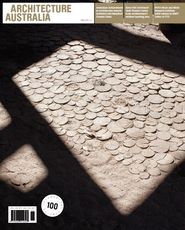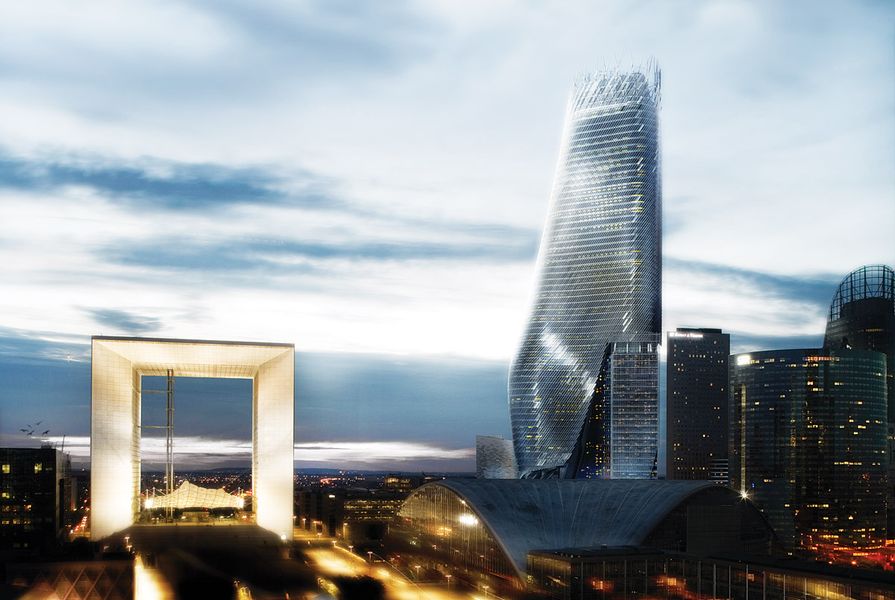Morphosis founder and design director Thom Mayne was introduced on the Perth leg of the Institute’s International Speaker Series tour by local architect Geoff Warn who, with tongue firmly in cheek, lauded him as one of the small but distinguished group of international architects who have lectured in Perth. Among others, Warn mentioned the architects that he and Bill Busfield had brought to lecture in Perth in the late 1980s and early 1990s, such as Wolf Prix and Peter Cook, the latter from Busfield’s alma mater, the Architectural Association in London. Perth’s architectural community has long been connected to such international networks and the exchange of ideas that results from them. There are those who arrive as migrants to this isolated place to practise (modernists such as Iwan Iwanoff and Jeffrey Howlett) or teach (at UWA alone, William Taylor, Charles Mann, Joo Hwa (Philip) Bay, Busfield, Patrick Beale, Patric De Villiers, Andrea Quagliola and Emiliano Roia) and those who leave and come back (of the younger generation, Eamon Broderick). As an undergraduate I remember the enthusiasm with which visiting lectures from Future Systems, Kathryn Findlay, John Andrews and Paul Hirst were greeted by the profession, academics and students. In the nineties, student-run groups like UWA’s John Dory Club and Curtin-based Red Studio held more intimate presentations by local as well as visiting national and international architects. And of course there are other, more fluid exchanges between the local and the international: Donaldson + Warn itself looked to California, among other places. (Indeed, Geoff Warn lived in Morphosis’s studio while working for them for a short time).
It is a pity that it has taken so long to recognize and harness this enthusiasm at a national level. While the Office of the Government Architect regularly sells out its Perth Samplings lecture series (to a broad and diverse audience – not just architects), this is the first of the Institute’s International Speaker Series lectures scheduled for Perth. Given that Mayne’s lecture was a full house in the crowded Christmas party season, we can hope that it’s a given that it won’t be the last.
Mayne began his lecture by quipping that Perth wasn’t the easiest place to get to, proving that the well-worn epithet of the “world’s most isolated city” still has currency. Equally well known in architectural circles (and with more pressing relevance) is a quote from Peter Reyner Banham’s 1971 book Los Angeles: The Architecture of the Four Ecologies, where he suggested that while Los Angeles is the “greatest City-on-the-Shore in the world … its only rival in potential is, probably, Perth, Western Australia.” While not referencing Banham directly, Mayne was quick to pick up on the similarities between these sprawling west coast autopias. Peering out of his Perth hotel room window, after the dislocation of a dozen international destinations in a number of weeks, Mayne adroitly observed that Western Australia’s capital has a “sense of nowhere” that characterized LA in the 1940s or 1950s. While his audience laughed nervously, Mayne suggested that California’s largest city is a place determined by the intersection of “infrastructure and capital” and “where the average person takes a beating.” Given the emphasis of Western Australia’s recent capital projects and the inequalities exposed by the state’s mining boom, these were prescient observations.
In view of the range of work presented, Mayne seems to be much less interested in the avant-garde than I remembered. Instead his concerns, and those of his Angeleno contemporaries when he started Morphosis, are those of a generation who reacted against the generic monotony of the extremes of modernity. A loose group, which included figures such as Eric Owen Moss and Frank Gehry, they sought to “take on [Ludwig] Hilberseimer,” as Mayne put it – perhaps a reference to the German émigré’s terrifyingly banal vision of the Welfare City. Instead, they proposed an architecture of idiosyncratic “specificity.” Mayne outlined a number of architectural “valences” that could be described as a reaction against modernity and a return to a number of pre-modern concerns – the continuity of the city, architecture’s role as an ordering device, project constraints as generative rather than limiting devices, and the acknowledgment of context. Mayne has pursued these objectives, he declared, without resorting to a predetermined architectural language. Instead, he asserted that this language emerged as part of the specific design “solution.” These parameters and the practice’s methodology were presented as a series of consistent approaches to issues of site, program and technology. While only three buildings – 41 Cooper Square in New York, the Phare Tower in Paris’s La Défense, and the Giant Interactive Group headquarters in Shanghai – were discussed in detail, other projects were used to illustrate the ideas that drew them cohesively together.
The striking staircase at the Cooper Union, 41 Cooper Square.
Image: Iwan Baan
For instance, the Phare Tower emerges from what Mayne described as a “non-site” in the new suburb of La Défense, defined not by its neighbouring buildings but instead by the infrastructure of the city – an expressway, a pedestrian bridge and a rail link. Like the staircase for Cooper Square or the four-storey annexe of the much taller San Francisco Federal Building, these buildings stretch out to engage with, activate or “mend” their sites. This architectural mending takes the form of programmatic activation and social engagement as well as spatial and formal definition. The fragmentary nature of the contemporary city is addressed by an architecture that aspires to the role of urban protagonist, where its contribution is greater than the site boundaries. Ordering, another of Mayne’s key architectural valences, is concerned with the relationships created between architectural elements and the testing of these proximities. This could be found at a range of scales - the distance between the skin and structure of the Phare Tower, Caltrans or Federal Building, the dispersal of programmatic elements along the hybrid building/landscape of the Giant building or the complex sections created between the skip-stop elevator lobbies and staircases at Cooper Square. Not simply approached as figure/ground, these are spatially complex works that reinforce Mayne’s argument that formal architectural language is found as part of the “solution,” rather than as a starting point to that solution. This approach then eschews the iconic or the “perfume bottle” as Mayne described the contemporary desire for instant formal legibility.
At the end of his presentation, almost as an afterthought, Mayne quickly scrolled through a number of images of work that his studio was currently undertaking. In response to his lament for the fixity of the computer-rendered image, these images were deliberately out of focus with a short depth of field, introducing an ambiguity to the depicted architectural form. These projects are found on the tabula rasa of the new frontiers of architectural ambition – the Middle and Far East. After such an eloquent, softly spoken, self-effacing and visually arresting presentation, these projects posed an awkward question about the future of Morphosis’s work. Here, unconstrained by the contingencies of the city, without a context to respond to or the need to recognize architecture’s responsibility to the deficiencies of the urban condition, it would appear that Morphosis is in danger of failing to heed Mayne’s own advice. Here in these new unlimited contexts, even with the ambiguity of blurred images, the idiosyncratic specificity appears to unravel.
While Mayne’s talk might not inspire students to travel to study or work with him as occurred after Prix’s and Cook’s visits, it is a reminder that, despite Perth’s geographic uniqueness, other places exist that share its metropolitan conditions. Just as in postwar LA, where a growing city generated a series of architectural, urban and social challenges, Perth faces a similarly testing future. Through understanding the mistakes and successes of other places and their architecture, this lecture reminds us of the need to elevate architecture’s role and relevance in a generic city.
Source

Discussion
Published online: 3 Jan 2012
Words:
Philip Goldswain
Images:
Iwan Baan
Issue
Architecture Australia, March 2011


















